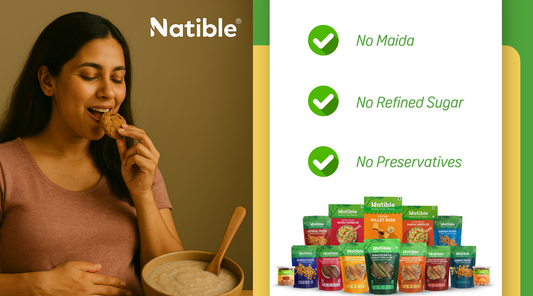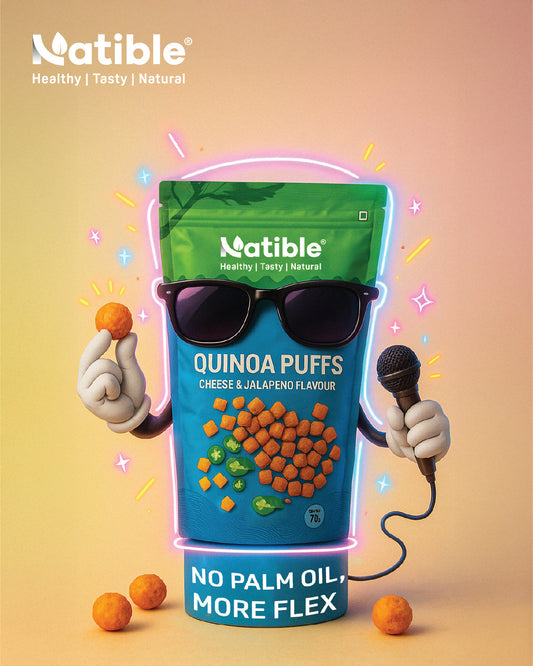When we talk about strong bones, calcium and Vitamin D are often the first nutrients that come to mind. But there's more to bone health than just dairy and sunlight. Ancient grains like millets, especially finger millet (ragi), foxtail millet, and pearl millet, are rising in popularity—not just for their climate resilience but also for their bone-boosting properties.
In this blog, we’ll explore:
- The nutritional profile of millets
- Research-backed benefits of millets for bone health
- The role of millet-based snacks in daily calcium intake
- Easy ways to add millets to your diet
Millets: Nature’s Reservoir of Bone-Friendly Nutrients
1. Finger Millet (Ragi) – The Calcium Champion
- Contains 344 mg of calcium per 100g, which is 10x more than rice or wheat.
- Also rich in phosphorus, potassium, and iron, contributing to bone mineralization.
- High polyphenol and dietary fiber content further enhance mineral absorption.
Study Highlight: A clinical trial on PubMed Central showed that adolescent girls consuming ragi regularly experienced improved calcium levels and bone density.
2. Foxtail Millet – Magnesium and Phosphorus Powerhouses
- These millets have moderate calcium but are excellent sources of magnesium, which is essential for converting vitamin D into its active form.
- High phosphorus content supports bone structure maintenance.
Scientific Evidence: Research in the Journal of the Research Society of Health Sciences revealed that magnesium deficiency among Indian women contributes to brittle bones, and including millets can help bridge this nutritional gap.
What Does Science Say About Millets and Bone Health?
A. Improved Bone Mineral Density (BMD)
A 2021 study on premenopausal women found that those incorporating finger millet into their diets showed a significant improvement in bone mineral density and overall calcium levels.
Source: International Journal of Food Sciences and Nutrition
B. Preventing Osteoporosis
According to a report by Pots & Pans India, millets—especially ragi—have great potential in preventing osteoporosis due to their high calcium content and superior nutrient bioavailability.
C. Higher Calcium Retention
A meta-analysis published in MDPI observed that regular millet consumption resulted in higher calcium retention compared to rice and wheat-based diets.
Millet-Based Snacks: A Delicious Way to Support Bone Health
Busy lifestyles often mean fewer sit-down meals and more on-the-go eating. Luckily, millet-based snacks aren’t just trendy—they're functional foods, packed with nutrients that support bone strength.
Why Choose Millet-Based Snacks?
- High in calcium and iron for both children and seniors
- Naturally gluten-free and anti-inflammatory
- Can be fortified with nuts or seeds for additional protein and minerals
Examples of Bone-Boosting Millet Snacks
- Ragi & sesame seed energy balls – Rich in calcium and zinc
- Foxtail millet crackers – A guilt-free, crunchy option
- Multi-millet nutri-bars – Made with nuts, jaggery, and millet flour
Explore more healthy recipes on our Nutrition Blog (Internal link suggestion if you have a recipe page).
How to Add Millets to Your Bone-Strengthening Diet
| Meal Type | Millet-Based Option |
|---|---|
| Breakfast | Ragi porridge or millet pancakes |
| Lunch | Foxtail millet khichdi or millet rotis |
| Snacks | Millet cookies, puffs, or protein bars |
| Dinner | Pearl millet soup or millet salad with curd |
Who Can Benefit the Most from Millets?
- Children: For optimal bone development
- Women: Especially during pregnancy, menopause, and postpartum
- Elderly: To maintain bone density and reduce fracture risk
- Vegans & lactose-intolerant individuals: A perfect non-dairy calcium source
Final Thoughts
If you’ve been relying solely on milk or supplements for your bone health, it’s time to turn to your kitchen. Millets, especially when consumed through millet-based snacks, provide a natural, wholesome, and delicious alternative to support your skeletal system.
Embrace millets—because science agrees, and now your plate can too.









